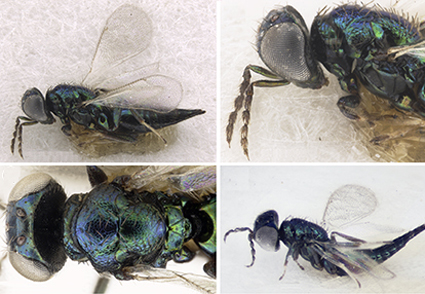Abstract
The Afrotropical species of the genus Pediobius (Hymenoptera, Eulophidae) characterized by extreme setation on the dorsal mesosoma are reviewed and grouped into a newly proposed setigerus group. This group is characterized by the broad attachment of the third funicular and first claval segments, so that the funicle is functionally 2-segmented with a 3-segmented clava. Four species are recognized for the group: P. setigerus Kerrich (from Ghana, Ivory Coast, Republic of Guinea, the Democratic Republic of the Congo, Uganda), P. multisetis Bouček (from Ivory Coast), P. sp. indet. aff. multisetis (from Uganda), and P. erinaceus Gumovsky sp. n. (from Uganda). This last species is associated with a leaf miner, and is easily recognizable in having numerous strong bristles on the lateral areas of the mesoscutum, along the notauli, and anterior margin of the mesoscutum, a smooth mesoscutellum with only one pair of thin setae, and the pronotal collar with only 6 thin setae. By contrast, in P. setigerus and P. multisetis the mesoscutellum is sculptured and bears a row of about 20 strong bristles on each side, and the pronotal collar also bears about 20 strong bristles. The differences between P. setigerus and P. multisetis, as well as issues on their biology and type material, are discussed.
References
Aneni, T.I., Aisagbonhi, C.I., Adaigbe, V.C. & Okere, C.I. (2014a) Ecology of Cotterelia podagrica (Hymenoptera: Eulophidae): a potential parasitoid of the oil palm pest, Coelaenomenodera elaeidis (Coleoptera: Chrysomelidae). Journal of Academia and Industrial Research, 3 (2), 63–66.
Aneni, T.I., Aisagbonhi, C.I., Iloba, B.N. & Adaigbe, V.C. (2014b) Life cycle of Petiobus setigerus (Kerrich) (Hymenoptera: Eulophidae): a parasitoid of the oil palm pest, Coelaenomenodera elaeidis (Coleoptera: Chrysomelidae). Journal of Academia and Industrial Research, 2 (8), 492–494.
Ashmead, W.H. (1904) Classification of the chalcid flies. Memoirs of the Carnegie Museum, 1, 225–551.
Baur, H., Kranz-Baltensperger, Y., Cruaud, A., Rasplus, J.Y., Timokhov, A.V. & Gokhman, V.E. (2014) Morphometric analysis and taxonomic revision of Anisopteromalus ruschka (Hymenoptera: Chalcidoidea: Pteromalidae)—an integrative approach. Systematic Entomology, 39 (4), 691–709. https://doi.org/10.1111/syen.12081
Bernon, G. & Graves, R.C. (1979) An outbreak of the oil palm leaf miner beetle in Ghana with reference to a new alternate host for its parasite complex. Environmental Entomology, 8 (1), 108–112. https://doi.org/10.1093/ee/8.1.108
Bouček, Z. (1976) Taxonomic studies on some Eulophidae [Hym.] of economic interest, mainly from Africa. Entomophaga, 21, 401–414. https://doi.org/10.1007/BF02371639
Bouček, Z. (1988) Australasian Chalcidoidea (Hymenoptera). A biosystematic revision of genera of fourteen families, with a reclassification of species. CAB International, Wallingford, Oxon and Cambrian News Ltd, Aberystwyth, Wales, 832 pp.
Burks, R.A., Heraty, J.M., Gebiola, M. & Hansson, C. (2011) Combined molecular and morphological phylogeny of Eulophidae (Hymenoptera: Chalcidoidea), with focus on the subfamily Entedoninae. Cladistics, 27, 1–25. https://doi.org/10.1111/j.1096-0031.2011.00358.x
Cao, H.X., LaSalle, J. & Zhu, C.-D. (2017) Chinese species of Pediobius Walker (Hymenoptera: Eulophidae). Zootaxa, 4240 (1), 1–71. https://doi.org/10.11646/zootaxa.4240.1.1
De Prins, J. & Heughebaert, A. (2019) Afromoths, online database of Afrotropical moth species (Lepidoptera). Version 1.7. Belgian Biodiversity Platform. Checklist dataset. Available from: https://www.gbif.org/ (accessed 19 February 2021) https://doi.org/10.15468/s1kwuw
Gibson, G. (1997) Morphology and Terminology. In: Gibson, G.A.P, Huber, J.T. & Woolley, J.B. (Eds.), Annotated keys to the genera of Nearctic Chalcidoidea (Hymenoptera). NRC Research Press, Ottawa, Ontario, pp. 16–44.
Gumovsky, A.V. (2011) Molecular data support the existence of four main lineages in the phylogeny of Eulophidae (Hymenoptera). Russian Entomological Journal, 20 (3), 273–286. https://doi.org/10.15298/rusentj.20.3.10
Gumovsky, A. (2018) New enigmatic species of the genus Pediobius (Hymenoptera, Eulophidae) from Afrotropics, with notes on related genera. Zootaxa, 4438 (2), 201–236. https://doi.org/10.11646/zootaxa.4438.2.1
Hansson, C. (2002) Eulophidae of Costa Rica (Hymenoptera: Chalcidoidea), 1. Memoirs of the American Entomological Institute, 67, 1–290.
Hansson, C. & Nishida, K. (2002) A new species of Pediobius (Hymenoptera: Eulophidae) from Epilachna (Coleoptera: Coccinellidae) in Costa Rica. Revista de Biologia Tropical, 50, 121–125.
Hernández-López, A., Rougerie, R., Augustin, S., Lees, D.C., Tomov, R., Kenis, M., Çota, E., Kullaj, E., Hansson, C., Grabenweger, G., Roques, A. & López-Vaamonde, C. (2012) Host tracking or cryptic adaptation? Phylogeography of Pediobius saulius (Hymenoptera, Eulophidae), a parasitoid of the highly invasive horse-chestnut leafminer. Evolutionary Applications, 5 (3), 256–269. https://doi.org/10.1111/j.1752-4571.2011.00220.x
Kerrich, G.J. (1970) On the taxonomy of some African Eulophidae (Hym., Chalcidoidea) associated with oil palm, coffee and mango. Bulletin of Entomological Research, 60 (2), 327–331. https://doi.org/10.1017/S0007485300040839
Kerrich, G.J. (1973) A revision of the tropical and subtropical species of the eulophid genus Pediobius Walker (Hymenoptera: Chalcidoidea). Bulletin of the British Museum (Natural History), Entomology, 29, 115–200.
Mariau, D. & Morin, J.Р. (1971) La Biologie de Coelaenomenodera elaidis Mlk. II. Description et Biologie des principaux parasites. Oleagineux, 26 (2), 83–88.
Mottern, J.L. & Heraty, J.M. (2014) Revision of the Cales noacki species complex (Hymenoptera, Chalcidoidea, Aphelinidae). Systematic Entomology, 39 (2), 354–379.
Noyes, J. (2019) Universal Chalcidoidea Database. Worldwide Web electronic publication. Last updated March 2019. Available from: http:// www.nhm.ac.uk/chalcidoids (accessed 25 January 2020).
Triapitsyn, S.V., Rugman-Jones, P.F., Tretiakov, P.S., Daane, K.M. & Wilson, H. (2020) Reassessment of molecular and morphological variation within the Anagrus atomus species complex (Hymenoptera: Mymaridae): egg parasitoids of leafhoppers (Hemiptera: Cicadellidae) in Europe and North America. Journal of Natural History, 54, 27–28 + 1735–1758. https://doi.org/10.1080/00222933.2020.1827073
Walker, F. (1846) Characters of some undescribed species of Chalcidites. (Continued). Annals and Magazine of Natural History, 17, 177–185. https://doi.org/10.1080/037454809495585


